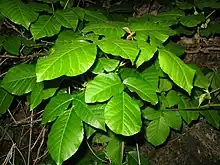| Toxicodendron orientale | |
|---|---|
 | |
| Toxicodendron orientale, Fukushima Prefect, Japan | |
| Scientific classification | |
| Kingdom: | Plantae |
| Clade: | Tracheophytes |
| Clade: | Angiosperms |
| Clade: | Eudicots |
| Clade: | Rosids |
| Order: | Sapindales |
| Family: | Anacardiaceae |
| Genus: | Toxicodendron |
| Species: | T. orientale |
| Binomial name | |
| Toxicodendron orientale | |
Toxicodendron orientale (Asian poison ivy) is an allergenic East Asian flowering plant in the genus Toxicodendron. The species was first characterized and named by Edward Lee Greene in 1905.[1] T. orientale is known to grow in Sakhalin, Japan, Taiwan, South central China, and South Korea. It was introduced to parts of Uzbekistan.[2]
Description
Toxicodendron orientale is a climbing vine that grows on trees or other supports. The deciduous leaves of T. orientale are trifoliate and grow to be 3-10 cm in length. Young branches are covered with small brown hairs that turn into red lenticels as the branches mature.
T. orientale flowers from May to June. The small yellow-green flowers grow in groups from the leaf axils. The flowers mature into yellow-brown fruit in August to September.
 Female flowers of T. orientale, Fukushima Prefect
Female flowers of T. orientale, Fukushima Prefect Male flowers of T. orientale, Mount Nishi-Azuma, Fukushima Prefect
Male flowers of T. orientale, Mount Nishi-Azuma, Fukushima Prefect Underside of T. orientale, Fukushima Prefect
Underside of T. orientale, Fukushima Prefect
Caution
All parts of Toxicodendron orientale contain urushiol, which is known to cause severe contact dermatitis.[3]
References
- ↑ Greene, Edward L. (1905), Leaflets of Botanical Observation and Criticism, vol. 1, Washington DC, p. 127, retrieved November 4, 2022
{{citation}}: CS1 maint: location missing publisher (link) - ↑ "Toxicodendron orientale". Plants of the World Online. Royal Botanic Gardens, Kew. Retrieved 4 November 2022.
- ↑ "Urushiol". PubChem. US National Library of Medicine. 1 January 2022. Retrieved 4 January 2022.